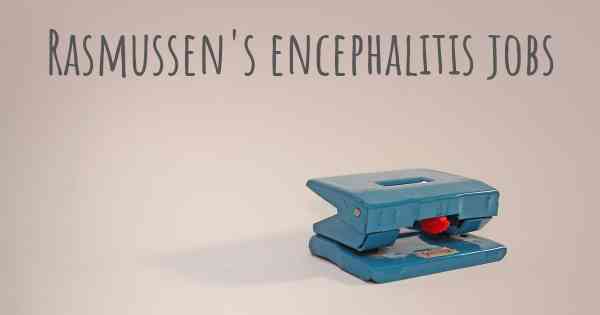Can people with Rasmussen's encephalitis work? What kind of work can they perform?
See how people with experience in Rasmussen's encephalitis give their opinion about whether people with Rasmussen's encephalitis can work and what kind of jobs are more appropriated for people with Rasmussen's encephalitis

Can people with Rasmussen's encephalitis work? What kind of work can they perform?
Rasmussen's encephalitis is a rare and chronic neurological disorder that primarily affects children. It is characterized by inflammation and progressive damage to one hemisphere of the brain, leading to seizures, cognitive decline, and neurological deficits. Given the nature of this condition, individuals with Rasmussen's encephalitis may face challenges in the workplace, but it is important to note that the impact can vary from person to person.
Employment Opportunities and Limitations
While Rasmussen's encephalitis can present significant obstacles, many individuals with this condition are still capable of working and contributing to society. The ability to work largely depends on the severity of the disease, the specific symptoms experienced, and the individual's overall cognitive and physical abilities.
It is crucial for individuals with Rasmussen's encephalitis to consult with their healthcare team, including neurologists and occupational therapists, to assess their capabilities and determine suitable employment options. These professionals can provide personalized guidance based on the individual's unique circumstances.
Flexible Work Arrangements
Flexible work arrangements can be particularly beneficial for individuals with Rasmussen's encephalitis. These arrangements allow for adjustments in work hours, workload, and work environment to accommodate the individual's needs and limitations. Some potential flexible work options include:
- Part-time work: Working fewer hours per week can help manage fatigue and allow for more time to rest and recover.
- Remote work: Working from home can provide a comfortable and controlled environment, reducing potential triggers for seizures or cognitive difficulties.
- Flexible schedules: Having the ability to modify work hours or take breaks as needed can help individuals manage their symptoms and optimize their productivity.
Job Selection and Modification
When considering employment, individuals with Rasmussen's encephalitis should focus on jobs that align with their abilities and limitations. Some factors to consider include:
- Physical demands: Jobs that require significant physical exertion or pose a risk of injury may not be suitable for individuals with motor impairments or weakness.
- Cognitive requirements: Certain jobs that demand high levels of concentration, memory, or multitasking may be challenging for individuals with cognitive deficits resulting from Rasmussen's encephalitis.
- Supportive work environments: Choosing workplaces that are understanding, accommodating, and supportive can greatly enhance the overall work experience for individuals with Rasmussen's encephalitis.
In some cases, job modifications can be made to enable individuals with Rasmussen's encephalitis to perform their tasks effectively. These modifications may include:
- Assistive technology: Using specialized software, devices, or tools can help compensate for certain cognitive or physical limitations.
- Workplace accommodations: Adjustments to the physical workspace, such as ergonomic furniture or noise reduction measures, can improve comfort and minimize distractions.
- Task delegation: Collaborating with colleagues or supervisors to delegate tasks that may be particularly challenging can help individuals focus on their strengths and contribute effectively.
Legal Protections
It is important for individuals with Rasmussen's encephalitis to be aware of their legal rights and protections in the workplace. In many countries, including the United States, laws such as the Americans with Disabilities Act (ADA) and the Rehabilitation Act prohibit discrimination against individuals with disabilities, ensuring equal employment opportunities.
These laws require employers to provide reasonable accommodations to individuals with disabilities, including those with Rasmussen's encephalitis, as long as the accommodations do not impose undue hardship on the employer. Reasonable accommodations can help individuals perform their job duties effectively while managing their condition.
Conclusion
While Rasmussen's encephalitis can present challenges in the workplace, many individuals with this condition can still pursue meaningful employment. The key lies in understanding one's limitations, seeking appropriate medical guidance, and exploring flexible work arrangements and job modifications. By doing so, individuals with Rasmussen's encephalitis can find fulfilling work opportunities that accommodate their unique needs and abilities.








